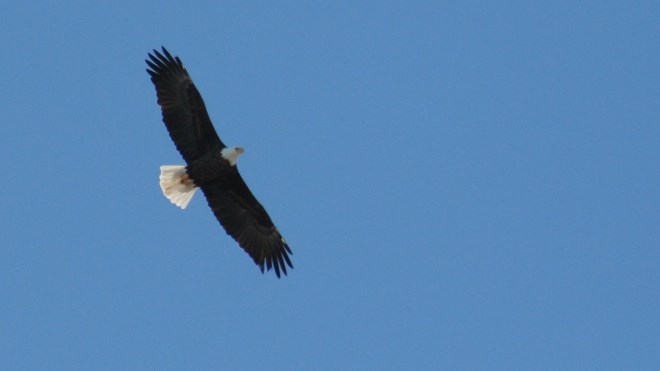I got a call one evening and was asked a question about a large bird that had soared over the caller’s car locally, very locally.
Surprised, he knew what he was looking at and hopefully not too distracted, was able to identify it to his satisfaction. It has an impact on most people when they get to see one of these. If we go back as recently as 20 years ago, it would have been almost unheard of, such a large bird in Greater Sudbury city limits.
His story comes at the same time as the big surprise we got this spring. One of the Sudbury Ornithological Society’s field trips in April was at one of the many lakes within the city limits, as these are evening ventures.
A large bird flew by and most got an excellent view of it, but one of our group trained his binoculars on it almost to the vanishing point. At great distance. he saw the bird go to a tree with a large nest. We were flabbergasted and excited at the same time. Watching from a distance over the course of the summer showed that, in fact, the nest was used by a pair of adults.
As the leaves broke out in the late spring, the nest was almost totally concealed. We were unable to tell if a youngster was reared.
Bald eagles are majestic birds that leave a lasting impression to most people who see one for the first time. They have a significant impact on Native culture. Their six-foot wing span rivals the size of a golden eagle and the slightly smaller turkey vulture.
Bald eagles take five years to reach the full adult plumage that we get to see in movies when they use these birds to make a point. Large white heads and white tail stand out in strong contrast to the deep chestnut brown body.
They often catch currents in the winds and will circle, increasing their height if need be, searching for food. I once watched a perched great blue heron turning its head in a strange position and looking straight up at the sky. What on earth was it looking at?
I followed its upward gaze and high in the sky was a circling bald eagle. The heron was keeping a watchful eye on this predator.
Bald eagles have made a healthy comeback since the banning of DDT in North America. Birds began to show up regularly in Sudbury within the last 10 years, particularly in winter as they flew across Ramsey Lake in search of food.
There were nine birds seen during the 2014 Christmas Bird Count. Their main diet in summer is fish and waterfowl, and winter scavenging activities become more pronounced.
Birds take a long time to mature, and when they find a mate the rearing process is slow. One to three eggs may hatch and it takes up to eight weeks for the eaglets to reach the point of independent flight.
The young look quite different from the adults. Their overall plumage is brown with a peppering of irregular white throughout that sometimes sees them mistaken for the rare golden eagle.
There is a good chance the reader can get a glimpse of a bald eagle this winter.
Look up for a large brown or dark bird circling with a flat plain to the wingspan. Circling ravens will appear all black where the larger eagle at a distance is a tone lighter.
Bald eagles have been sited circling over downtown Sudbury as well as many wilderness locations.
Chris Blomme is an executive member of the Sudbury Ornithological Society and works with animals at Laurentian University. Have a question for Chris? Send it to [email protected].
Join Sudbury.com+
- Messages
- Post a Listing
- Your Listings
- Your Profile
- Your Subscriptions
- Your Likes
- Your Business
- Support Local News
- Payment History
Sudbury.com+ members
Already a +member?
Not a +member?
Sign up for a Sudbury.com+ account for instant access to upcoming contests, local offers, auctions and so much more.
